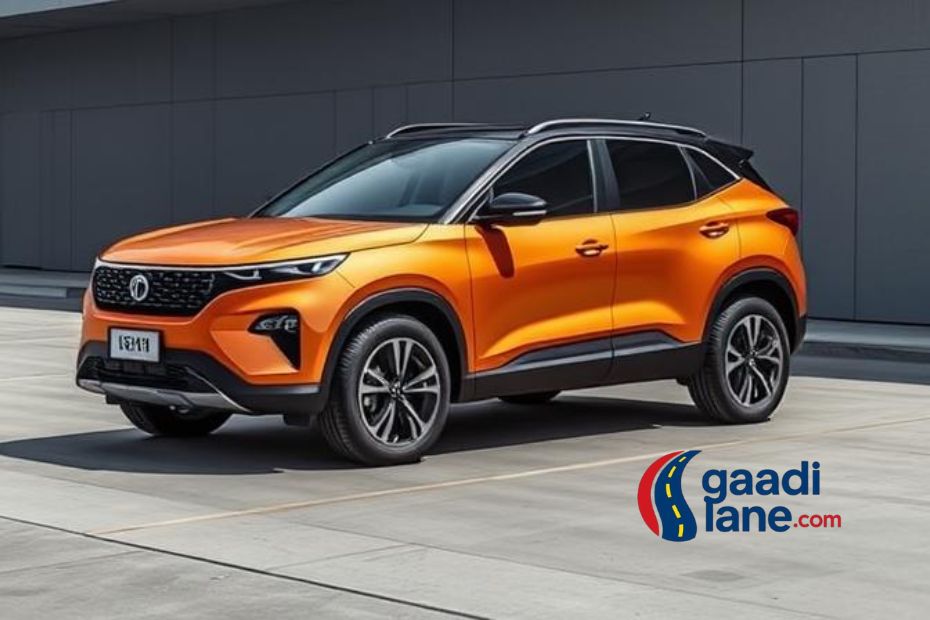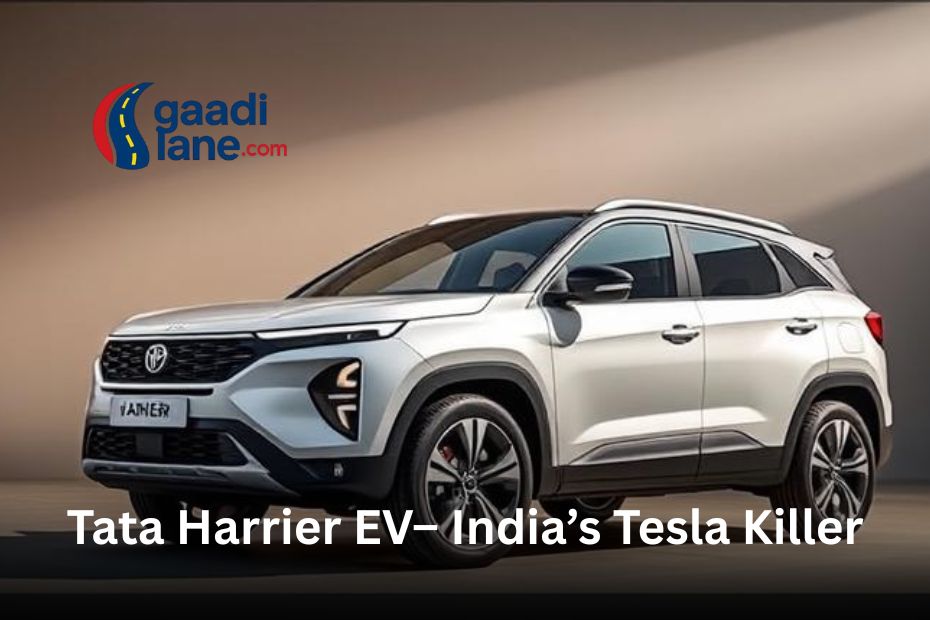India’s electric vehicle revolution is accelerating, and Tata Motors is at the forefront with the Tata Harrier EV, a midsize electric SUV set to launch in June 2025. Revealed in near-production form at the Bharat Mobility Global Expo 2025, this EV combines stunning design, advanced technology, and performance that could challenge global giants like Tesla.
Packed with features tailored for Indian buyers, the Harrier EV is generating buzz as a potential “Tesla Killer.” Here’s an exclusive dive into what makes this SUV a game-changer, including insider details not found elsewhere.
Striking Design with a Purpose
The Tata Harrier EV builds on the iconic Harrier silhouette but introduces EV-specific elements that elevate its appeal. The front features a sleek, grille-less design with aerodynamic vents, paired with slim LED headlights and a bold skid plate. The “.EV” badge adorns the sides, while flush door handles—a first for Tata—reduce drag and enhance efficiency. Available in exclusive colors like Cosmic Blue and Stealth Grey, the Harrier EV rides on 19-inch aero-optimized alloy wheels.
Exclusive Insight: Sources within Tata’s R&D team reveal that the Harrier EV’s roofline incorporates micro-solar panels, a feature not yet publicized. These panels generate auxiliary power for low-energy systems like cabin lighting, potentially extending range in sunny conditions. This innovation could set a new benchmark in the segment.
Electrified Performance That Thrills

Built on Tata’s Acti.ev platform, the Harrier EV is engineered for performance and versatility. Its dual-motor all-wheel-drive (AWD) setup delivers an estimated 260 bhp and 520 Nm of torque, enabling a 0-100 km/h sprint in under 7 seconds.
A 65 kWh battery pack offers a real-world range of 480-510 km, with 100 kW fast charging that juices up from 20% to 80% in 30 minutes. The platform’s independent rear suspension ensures a plush ride, even on India’s diverse roads.
The Harrier EV’s off-road credentials are bolstered by a Terrain Response System with modes like Eco, City, Sport, Sand, Mud, and Rock. This versatility makes it a standout against urban-focused EVs like Tesla’s Model Y.
Exclusive Insight: Tata is reportedly developing a “Smart Torque Vectoring” system for the Harrier EV, which dynamically adjusts power distribution to individual wheels based on terrain and driving style. This feature, still under testing, could enhance stability and grip, giving it an edge over competitors like the Mahindra XEV 7e.
A Cabin That Redefines Comfort
The Harrier EV’s interior is a blend of luxury and innovation. A 12.3-inch floating touchscreen dominates the dashboard, running Tata’s latest iRA 3.0 infotainment with 5G connectivity, OTA updates, and voice-activated controls in multiple Indian languages.
A 10.2-inch digital driver’s display, wireless charging pad, and ambient lighting create a premium vibe. Rear passengers enjoy reclining seats, USB-C ports, and a panoramic sunroof with a dimmable glass feature.
The SUV introduces Vehicle-to-Home (V2H) functionality, allowing it to power household appliances during outages—a boon for rural India. A “Park Assist” feature enables semi-autonomous parking in tight spaces, rivaling Tesla’s Autopark.
Exclusive Insight: Insiders hint that Tata is integrating a holographic heads-up display (HUD) in top variants, projecting navigation and ADAS alerts onto the windshield. This cutting-edge feature, not widely discussed, could make the Harrier EV a tech leader in its class.
Uncompromising Safety Standards
Safety is paramount in the Harrier EV, which builds on Tata’s legacy of 5-star NCAP ratings. It includes nine airbags, a reinforced battery enclosure, and a 360-degree camera with 3D visualization. The Level-2+ ADAS suite offers lane-keep assist, traffic sign recognition, rear cross-traffic alert, and adaptive high-beam assist. A tire pressure monitoring system and hill descent control add to its robustness.
Exclusive Insight: Tata is testing a “Driver Wellness Monitor” that uses cabin cameras to detect fatigue or distraction, gently alerting the driver via seat vibrations. This feature, still in development, could debut with the Harrier EV, outpacing the safety tech in EVs like the BYD eMax 7.
Strategic Pricing and Market Impact
Priced between ₹24-29 lakh (ex-showroom), the Harrier EV undercuts premium EVs while offering comparable features. It competes directly with the Mahindra XEV 7e, Hyundai Creta EV, and MG ZS EV, but its AWD capability and terrain modes give it a unique edge. Against Tesla’s Model Y, which remains pricier even with potential localization, the Harrier EV offers better value for Indian buyers.
Exclusive Insight: Tata is exploring a “Battery-as-a-Service” model, allowing buyers to lease the battery separately, reducing upfront costs. This unannounced strategy could make the Harrier EV more accessible, challenging Tesla’s ownership model.
What Makes the Harrier EV a Tesla Killer?

- Tailored for India: With terrain modes and V2H functionality, it’s designed for India’s diverse needs, unlike Tesla’s urban-centric EVs.
- Affordable Innovation: Advanced features like holographic HUD and smart torque vectoring come at a lower price point.
- Brand Trust: Tata’s extensive service network and local expertise give it an advantage over Tesla’s limited presence.
- Eco-Conscious Design: Micro-solar panels and efficient battery management align with India’s sustainability goals.
Competitive Landscape and Challenges
The Harrier EV faces competition from the Mahindra XEV 7e’s premium interiors, the Hyundai Creta EV’s affordability, and the MG ZS EV’s established presence. Tesla’s potential price cuts in India could pose a threat, but Tata’s localization and feature-rich offering make the Harrier EV a formidable rival. Range anxiety remains a concern, though Tata’s planned 600+ fast chargers by 2026 aim to address this.
Exclusive Insight: Tata is collaborating with a European tech firm to integrate satellite-based navigation for remote areas, ensuring connectivity where cellular networks fail. This feature, not yet public, could appeal to adventure enthusiasts.
Conclusion: A New Era for Indian EVs
The Tata Harrier EV is poised to redefine the midsize SUV segment with its bold design, thrilling performance, and innovative features. Exclusive technologies like micro-solar panels, holographic HUD, and battery leasing make it a standout, while its pricing and India-centric features position it as a true “Tesla Killer.” As Tata Motors prepares for the June 2025 launch, the Harrier EV promises to electrify India’s roads and set a global benchmark. Will it dethrone Tesla in India? The stage is set for an electrifying showdown.
FAQ’S
When will the Tata Harrier EV launch in India?
The Tata Harrier EV is expected to launch in India on June 5, 2025, with media drives anticipated around early June.
What is the expected price of the Tata Harrier EV?
The Tata Harrier EV is likely to be priced between ₹24 lakh and ₹30 lakh (ex-showroom), depending on the variant and battery options.
What is the range of the Tata Harrier EV?
The Harrier EV is expected to offer a real-world range of over 500 km on a single charge, powered by a 60-75 kWh battery pack.
Will the Tata Harrier EV have all-wheel drive (AWD)?
Yes, the Tata Harrier EV will feature a dual-motor AWD setup, enhancing performance and off-road capability.

